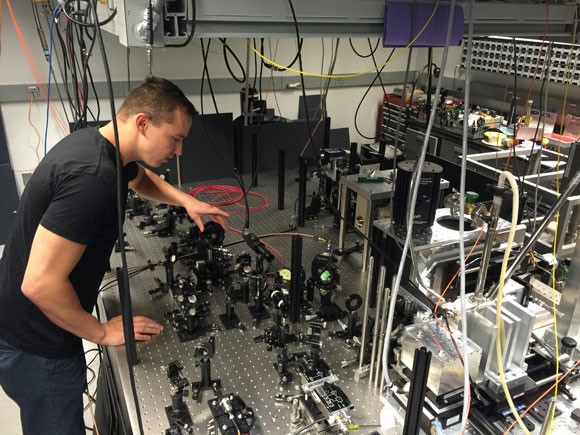
Long predicted by quantum mechanics, the effects of quantum entanglement are observable even if scientists don’t quite understand its underpinnings. Entanglement suggests that two particles may link in such a way that the state of one particle instantly influences the state of the other regardless of their distance. Recreating this odd behavior in the lab required that scientists cool things down to near absolute zero and then apply a massive magnetic field. But now, scientists from the University of Chicago and Argonne National Laboratory have successfully produced macro-scale quantum entanglement at room temperature and with a small magnetic field.
The new process relies on using an infrared laser light to order and preferentially align the magnetic states of thousands of electrons and nuclei before applying electromagnetic pulses, similar to kind used by conventional MRI machines. When the technique was wrought upon a macroscopic 40 micrometer-cubed volume of the semiconductor SiC (silicone carbide), pairs of its electrons and nuclei became entangled.
“We know that the spin states of atomic nuclei associated with semiconductor defects have excellent quantum properties at room temperature,” said Awschalom, the Liew Family Professor in Molecular Engineering and a senior scientist at Argonne. “They are coherent, long-lived and controllable with photonics and electronics. Given these quantum ‘pieces,’ creating entangled quantum states seemed like an attainable goal.”
Other than realizing a new discovery in what’s arguably considered the underlying theory of modern physics, “the ability to produce robust entangled states in an electronic-grade semiconductor at ambient conditions has important implications on future quantum devices,” explained David Awschalom, the Liew Family Professor in Molecular Engineering and a senior scientist at Argonne. Meaning, the groundbreaking technique could spur the further development of quantum computers, quantum communication networks, high-precision quantum sensors, and quantum cryptography.
The short term proposition we’re looking at may be the inception of quantum sensors that leverage entanglement as a means of detecting infinitesimal particle-level changes, and overcoming the sensitivity limit of traditional sensors. The team points out that the ambient conditions that now permit entanglement, which when combined with the bio-friendliness of SiC, makes real-time bio-sensing within a living organism quite feasible.
And in the long term, the ability of a quantum state on one SiC chip to influence the state of another across a long-distance, could spell out a revolution in secure quantum communication. Or at the very least, the process could be used to synchronize global positioning satellites.
Source: Scitechdaily
Advertisement
Learn more about Electronic Products Magazine





